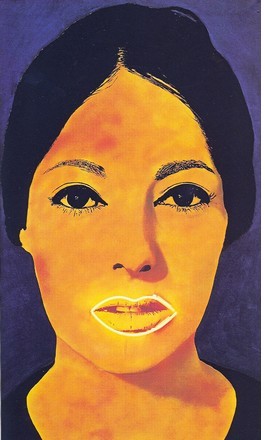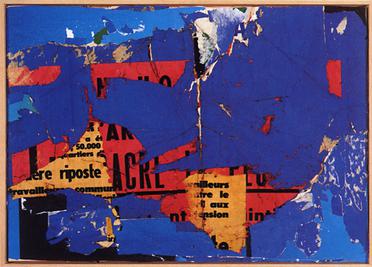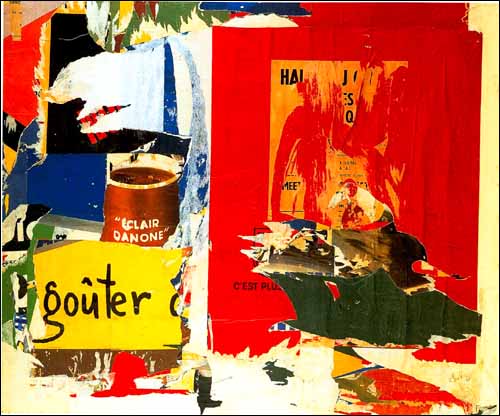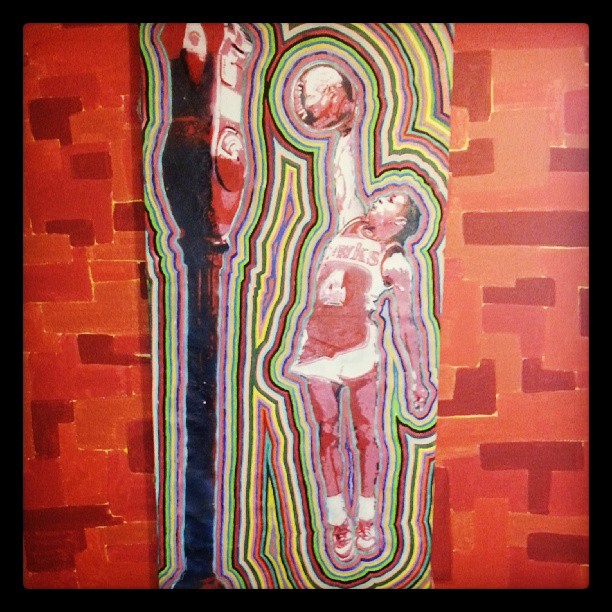
Washington Oddities and other interesting stuff: Morris Louis (From Wikipedia)
Washington Oddities and other interesting stuff: Morris Louis (From Wikipedia): Morris Louis (born Morris Louis Bernstein, 28 November 1912 – 7 September 1962) was an American painter. During the 1950s he became ...
Martial Raysse
Martial Raysse is a French artist born in Golfe-Juan on
February 12, 1936. He lives in Issigeac - France. Raysse was born in a
ceramicist family in Vallauris and began to paint and write poetry at age 12.
After studying and practising athleticism at a high level, he began to
accumulate rubbish odds and ends that he preserved under plexiglas. In 1958, he
exhibited some of his paintings with Jean Cocteau at Galerie Longchamp.
Fascinated by the beauty of plastic, he plundered
low-costs shops with plastic items and developed what became his "vision
hygiene" concept; a vision that showcases consumer society. This work
received attention and critical praise in 1961 and at a commercial gallery in
Milan, his exhibition sold out 15 minutes before the opening. Raysse then
traveled to the United States to get involved with the pop art scene in New
York City.
In October 1960, Martial Raysse, together with Arman,
Yves Klein, François Dufrêne, Raymond Hains, Daniel Spoerri, Jean Tinguely,
Jacques Villeglé and the art critic and philosopher Pierre Restany founded the
group Nouveaux Réalistes. The group was later joined by César, Mimmo Rotella,
Niki de Saint Phalle and Christo. This group of artists defined themselves as
bearing in common a "new perspective approaches of reality". Their
work was an attempt at reassessing the concept of art and the artist in the
context of a 20th Century consumer society by reasserting the humanistic ideals
in the face of industrial expansion.
Nouveau réalisme (new realism) refers to an artistic
movement founded in 1960 by the art critic Pierre Restany and the painter Yves
Klein during the first collective exposition in the Apollinaire gallery in
Milan. Pierre Restany wrote the original manifesto for the group, titled the
"Constitutive Declaration of New Realism," in April 1960,
proclaiming, "Nouveau Réalisme—new ways of perceiving the real."
This joint
declaration was signed on October 27, 1960,
in Yves Klein's workshop, by nine people: Yves Klein, Arman, Martial Raysse,
Pierre Restany, Daniel Spoerri, Jean Tinguely and the Ultra-Lettrists, Francois
Dufrêne, Raymond Hains, Jacques de la Villeglé; in 1961 these were joined by
César, Mimmo Rotella, then Niki de Saint Phalle and Gérard Deschamps. The
artist Christo showed with the group.
Contemporaries of American pop art, and often conceived
as its transposition in France, new realism was, along with Fluxus and other
groups, one of the numerous tendencies of the avant-garde in the 1960s. It was
dissolved in 1970.
The first exposition of the nouveaux réalistes took place
in November 1960 at the Paris "Festival d'avant-garde." This
exposition was followed by others: in May 1961 at the Gallery J. in Paris;
International Exhibition of the New Realists, a survey of contemporary American
Pop Art and the Nouveau Réalisme movement at the Sidney Janis Gallery in New
York at the end of 1962; and at the Biennale of San Marino in 1963 (which would
be the last collective show by the group). The movement had difficulty
maintaining a cohesive program after the death of Yves Klein in June, 1962.
The members of the nouveaux réalistes group tended to see
the world as an image from which they could take parts and incorporate them
into their works—as they sought to bring life and art closer together.
They
declared that they had come together on the basis of a new and real awareness
of their "collective singularity", meaning that they were together in
spite of, or perhaps because of, their differences. But for all the diversity
of their plastic language, they perceived a common basis for their work; this
being a method of direct appropriation of reality, equivalent, in the terms
used by Pierre Restany, to a "poetic recycling of urban, industrial and advertising
reality".
Thus the nouveaux réalistes advocated a return to
"reality" in opposition to the lyricism of abstract painting. They
also wanted to avoid what they saw as the traps of figurative art, which was
seen as either petty-bourgeois or as Stalinist socialist realism. Hence the
Nouveau Réalistes used exterior objects to give an account of the reality of
their time. They were the inventor of the décollage technique (the opposite of
collages), in particular through the use of lacerated posters—a technique
mastered by François Dufrene, Jacques Villeglé, Mimmo Rotella and Raymond
Hains. Often these artists worked collaboratively and it was their intention to
present their artworks in the city of Paris anonymously.
The term "new realism" was first used in May
1960 by Pierre Restany, to describe the works of Arman, François Dufrêne,
Raymond Hains, Yves Klein, Jean Tinguely and Jacques Villeglé as they exhibited
their work in Milan. He had discussed this term before with Yves Klein (who
died prematurely in 1962), who preferred the expression "today's
realism" (réalisme d'aujourd'hui) and criticized the term "New."
After the first "Manifesto of New Realism," a second manifesto,
titled "40° above Dada" (40° au-dessus de Dada) was written between
17 May and 10 June 1961. César, Mimmo Rotella, Niki de Saint-Phalle (then
practicing "shooting paintings") and Gérard Deschamps then joined the
movement, followed by Christo in 1963. Klein, however, started to distance himself
from the group around 1961, disliking Restany's insistence on a Dadaist
heritage.
Nouveau réalistes made extensive use of collage and
assemblage, using real objects incorporated directly into the work and
acknowledging a debt to the readymades of Marcel Duchamp. But the New Realism
movement has often been compared to the Pop Art movement in New York for their
use and critique of mass-produced commercial objects (Villeglé's ripped cinema
posters, Arman's collections of detritus and trash), although Nouveau Réalisme
maintained closer ties with Dada than with Pop Art.
The LLR: Writers on life
The LLR: Writers on life: Richard Smith, Package, 1962 Nothing will ever be attempted, if all possible objections must first be overcome.-- Samuel Johnson ...
The LLR: Cannery Row excerpt
The LLR: Cannery Row excerpt: Marisol, La Visita, 1964 Cannery Row in Monterey in California is a poem, a stink, a grating noise, a quality of light, a tone, a ha...
The LLR: Catcher in the Rye, excerpt
The LLR: Catcher in the Rye, excerpt: Man in a museum, David Hockney, 1962 IF YOU REALLY WANT TO HEAR about it, the first thing you'll probably want to know is where I ...
The LLR: Great Writing
The LLR: Great Writing: Great writing Warhol. Orange Car Crash 10 Times. 1963 Cherish your vision...
The LLR: To Kill a Mockingbird, excerpt.
The LLR: To Kill a Mockingbird, excerpt.: Landscape no 2, Tom Wesselmann, 1964 When I was almost six and Jem was nearly ten, our summertime boundaries (within calling dis...
The Pop Object ‘The Still Life Tradition in Pop Art’
100 11th Avenue, at 19th Street,
Chelsea
Through May 18
Benny Andrews was born into a sharecropping family in Plainview, Ga., in 1930; went to a local college on a scholarship, dropped out, joined the Air Force and ended up at the Art Institute of Chicago, where, as one of the few black students, he felt ill at ease. By the end of the 1950s he was in New York, making figurative paintings that were also collages and sculptural reliefs built up from scraps of recycled clothing. The work, social and political in content, had little to do with mainstream styles of the day.
The 36 pictures at Michael Rosenfeld span Andrews’s career. One of the earliest pieces, “Dinner Time” from 1965, is a straightforward oil-on-canvas domestic scene; “Liberty #6 (Study for Trash) (Bicentennial Series),” made six years later, is a symbolic depiction of a parade float carrying headless nude soldiers and a woozy blond, flag-swathed Lady Liberty. In the time between those pictures, Andrews (who died in 2006) was active in the civil rights movement, taught art in a New York jail, and helped found the Black Emergency Cultural Coalition, which campaigned to have major museums recognize African-American art.
Allegory and genre, sometimes combined, remained his dominant modes; experiments with high-relief fabric collage continued. In subject Andrews’s art continued to be of its time; in form it never was, which limited its circulation. Rosenfeld, working with Andrews’s widow, the artist Nene Humphrey, is working to give the career the visibility it deserves. An institutional survey, accompanied by an edition of Andrews’s invaluable and voluminous journals, is in order, letting us see an important body of work and an important American life in full.
Acquavella Galleries
18 East 79th Street,
Manhattan
Through May 24
Pop Art’s continuation and subversion of the still life tradition is not exactly a new idea, given that the first museum show devoted to Pop — at the Pasadena Art Museum in California in 1962 — was titled “New Painting of Common Objects.” This show, organized by the art historian John Wilmerding, is accompanied by an ostentatious catalog at least partly designed to encourage sales, and is installed almost as gracelessly as an auction-house display. Still, it has clarity on its side, thanks to Mr. Wilmerding’s thematic divisions: flowers and plants, household objects, body parts and clothes, and food and drink. It also expands beyond the usual Pop suspects to include the slyly three-dimensional paintings (depicting roses and lima beans) of Marjorie Strider and a soft sewn-and-stuffed-fabric coffee-table still life by Jann Haworth, as well as works by John Wesley, Stephen Antonakos, Robert Arneson and H. C. Westermann. The vacuum-cleaner piece by Jeff Koons is perhaps an expansion too far.
But mainly this is a great cherry-picking exhibition, most notable for a handful of unfamiliar, rarely exhibited or outstanding works. Among these are Jim Dine’s “Five Feet of Colorful Tools” (1962), with its playful confusion of objects, shadows and silhouettes; Vija Celmins’s giant hyper-real sculptures of a pencil and a rubber eraser, as spellbinding as ever; and Marisol Escobar’s carved wood (with drawing and painting) portrait of Andy Warhol. Edward Kienholz’s “Cement TV,” a portable television neatly coated with cement, seems sardonically anti-Pop. The show’s oddest surprise may be “Steel Plant II Rubber,” a welded-steel representation of a rubber (not a steel) plant by Larry Rivers, from 1959. The single most thrilling sight by far is Roy Lichtenstein’s “Black Flowers” from 1961, a somewhat crudely rendered masterpiece that merges painting, drawing and commercial printing. At once exuberant and desiccated, and on loan from the Los Angeles collector Eli Broad, it justifies the whole show. ROBERTA SMITH
POP! goes the Figge
A piece from Andy Warhol's "Ladies and Gentlemen," foreground, is on display in the exhibit "American POP!" at the Figge Art Museum in Davenport.
IF YOU GO
What: "American POP!"
When: Today through Sept. 8; hours are 10 a.m. to 5 p.m. Mondays through Saturdays and noon to 5 p.m. Sundays; there is free admission for nonmembers from 5 to 8 p.m. Thursdays
Where: Figge Art Museum, 225 W. 2nd St., Davenport
How much: $7 for adults, $6 for senior citizens (60 years and older) and students with an ID, $4 for those 3-12 years old
Information: 563-326-7804 or FiggeArtMuseum.org
Among the various colorful pieces in the gallery at the Figge Art Museum's new pop art exhibit are three large blueprints.
Most of us see blueprints as more practical than artistic, but these bear a second look when you see the locations depicted:
• Wayne Manor, the home of Bruce Wayne and Dick Grayson, the alter egos, respectively, of Batman and Robin.
• The home of Mike and Carol Brady of Los Angeles, which housed their bunch of kids and a maid. (For the record, it has three bathrooms.)
• A plat of the "city" of Mayberry, N.C., where Sheriff Andy Taylor kept the peace.
Is it art? It's seen as that in "American POP!" opening this weekend at the Figge in downtown Davenport.
Curated by the CU Art Museum at the University of Colorado in Boulder, "American POP!" has its Andy Warhol representation (a pair of 1974 silkscreens from his "Ladies and Gentlemen" series), a pair of Roy Lichtensteins (including one of a pointing finger titled "Untitled (Finger Pointing)" and some works by Robert Rauschenberg, with three rather one in various styles.
But there's also a re-creation of a Brillo pad label; works by artist John Baeder, who has three portraits of classic old diners, and linocut artist Wayne Theibaud's delicious "Boston Cremes," which shows 10 desserts ready for the taking.
"Some of the art exhibited here is not traditionally seen as pop art," Figge associate curator Rima Girnius said.
The works, she added, are reactions to both the modern expressionist era and the consumer-driven culture that drove America after World War II.
"Pop artists really abandoned expressionist and embraced a more external environment," she said. "They tried to reverse the elitism of abstract expressionism."
The end of the war brought a continuous set of changes, she said.
"Life was completely transformed by the presence of ovens and washing machines and supermarkets that provided massive amounts of cheaply packaged foods," she said.
"Pop art was kind of a response to this consumer-driven society because they appropriated sort of simple, everyday materials and imagery that was taken from the mass media world," she added.
That includes seeing the homes of the Bradys, Batman and Barney Fife.
"The homes that we see on television seem nearer and dearer to us than the homes of our neighbors," Girnius said. "We know more about these fictional families than our neighbors."
"American POP!" she added, "sort of reflects a media-obsessed culture."
Lyman Allyn Art Museum opens Pop Art exhibition
Lyman
Allyn Art Museum announces the exhibition, "Pop Goes the Easel: Pop Art
and its Progeny", opening March 3 and on view through Aug. 10. The
exhibition is guest curated by Barbara Zabel, Ph.D. professor emeritus at
Connecticut College.
By
exploring traditional modes of easel painting, Pop artists of the 1960s
radically expanded the possibilities of how art is made and how it is viewed;
thus they opened up multiple pathways for artists coming to maturity in later
decades of the twentieth century.
Pop
Goes the Easel includes works by male pop stars like Andy Warhol and Roy Lichtenstein,
as well as works by women artists like Idelle Weber and Marjorie Strider, who
were marginalized in the male-dominated decade of the 60s. The exhibition also
explores the myriad avenues opened up by Pop in the more politically engaged
decades that followed.
Exhibition
programs and events:
Gallery
Talk
March
6: Pop Goes the Easel! with Barbara Zabel and Devon Elovitz, at 4 p.m.
Admission for members is $5, for non-members it is$10. To make reservations,
call (860) 443-2545, Ext. 129.
Artist
Talk
March
28: Let ‘er Buck, artist Nancy Davidson; Reception at 5 p.m., presentation at 6
p.m. Admission for members is $5, for non-members it is $10. Call (860)
443-2545, Ext. 129 to make reservations.
Lecture
April
4: "Pop on the Dark Side: Performance Art and Pop Art" by Karen
Gonzalez Rice, Connecticut College Art History Professor; Reception at 5 p.m.,
lecture at 6 p.m. Admission for members is $5, for non-members it is $10. For
reservations, call (860) 443-2545, Ext. 129.
Film
Screening
April
11: "The Films of Andy Warhol," with Ross Morin, Connecticut College
Film Studies Professor, at 4:30 p.m. Admission for members is $5, for
non-members it is $10. Call (860) 443-2545, Ext. 129 to make reservations.
Lecture
May
16: "Lichtenstein Revisited" with Janis Hendrickson Mink, Reception
at 5 p.m., lecture at 6 p.m. Admission is $5 for members, $10 for non-members.
To make reservations, call (860) 443-2545, Ext. 129.
Free
First Saturdays
Join
us each month for a fun family day with free admission from 10 a.m. to noon.
Art
activities and snacks for ages 5 – 12 are available on First Saturdays from 1
to 3 p.m., free with Museum admission.
Check www.lymanallyn.org for updates and additional programming. Tours of the exhibition will be available for groups. Lyman Allyn Art Museum is located at 625 Williams Street in New London.
Check www.lymanallyn.org for updates and additional programming. Tours of the exhibition will be available for groups. Lyman Allyn Art Museum is located at 625 Williams Street in New London.
Pop goes the art classes at the Campbell River gallery
Are you ready to get Poptastic? Join instructor Shannon McKirgan for a fun and educational kids’ class all about Pop Art at the Campbell River Art Gallery in May.
The class, for children aged seven to 12, takes place over three sessions, Wednesdays, May 8, 15 and 22, from 3 p.m. to 5 p.m. Kids will be inspired by Pop Art geniuses like Andy Warhol, Wayne Thiebaud, David Hockney and Claes Oldenburg, as they create a range of pop art pieces, including photo collage, portraits and soft sculpture. Pop art saw imagery from popular culture infilltrate fine art and it was pop-a-rific!
Instructor Shannon McKirgan is a painter and recent Emily Carr University graduate. Her work has been exhibited locally - most recently at the CR Art Gallery’s 31st Annual Members’ Exhibition, where she won an Award of Excellence, and the Muir Gallery in Courtenay. She has an upcoming solo show at the George Sawchuk Gallery.
The cost for Pop Art Pandemonium is $43 for CR Art Gallery members and $53 for non-members. All supplies are included. Winter/Spring Children’s Classes are sponsored by the Friends of CR Art Gallery.
Stop by the Campbell River Art Gallery Tuesday to Saturday from 12 p.m. to 5 p.m., call 250-287-2261, or email programs@crartgallery.ca to find out more about this great kids’ class.
Subscribe to:
Posts (Atom)

.jpg)























%20-1.jpg)









.jpg)
1975.jpg)

+andy+warhol.jpg)









